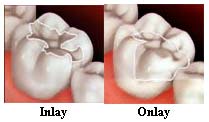What is it ?
A dental inlay or onlay is bigger than a filling and smaller than a crown. It is bonded or cemented into place.
An inlay is similar to a filling, but it lies within the cusps (bumps) on the chewing surface of your tooth. An onlay is larger than an inlay. It replaces one or more decayed cusps.

Inlays or onlays can be made of gold, composite resin (plastic) or ceramics. They can last for 10 years or longer. How long they last depends on:
- The material used
- The teeth involved
- The forces of chewing
- How well you maintain them with good oral hygiene and regular visits us
What it is used for?
An inlay or onlay is one way to restore a damaged or decayed tooth.
Preparation
The tooth and surrounding area will be numbed with local anesthesia. Some people also may be given nitrous oxide or another type of sedation.
How its done ?
There are two types of inlays and onlays: direct and indirect. Direct inlays and onlays are made in the dental office. They are placed in one visit. Indirect inlays and onlays are made in a laboratory. Two visits are needed to place them.
The type we will use depends on how much of the tooth is left.
1.Direct Inlays and Onlays:
We will remove the decay and shape the tooth. He or she will put a soft material called composite resin on the tooth. The composite resin is molded to fit the tooth. The inlay is removed and hardened in a special oven. Then, we will cement the hardened inlay to your tooth. After the inlay is cemented, it will be polished. We may have to shape it slightly to adjust the way your teeth come together.
There is also new technology that allows the dentist to have a ceramic inlay or onlay made in the office and cemented on at the same visit.
2.Indirect Inlays and Onlays:
We will remove the decay. He or she then will make an impression of the prepared tooth and neighboring teeth. The tooth will get a temporary filling. The impression will be sent to a laboratory, which will make the inlay or onlay.
At your second visit, your dentist will take out the temporary filling and clean and dry the tooth. He or she will then cement the inlay or onlay to the tooth. Then it will be polished. We may have to shape it slightly to adjust the way your teeth come together.
Some dentists have a machine that allows the dentist to take a picture (instead of an impression) of the prepared tooth. Then a computer guides the machine in making a ceramic inlay, onlay or crown. This process can take less than one hour. Your inlay or onlay can then be cemented into place at the same visit.
Follow up ?
Inlays and onlays require only brushing and flossing. You also should visit us regularly.
Risks?
Inlays and onlays can come loose if the cement washes out or combines with saliva while it is being applied. Therefore, it’s important for the area to be kept dry when the inlay or onlay is cemented to the tooth. Inlays and onlays made of composite resin or porcelain can crack.
When to call a professional ?
After receiving an inlay or onlay, contact us if your tooth is sensitive for more than a couple of days. Also call if the inlay or onlay becomes loose or falls out.
